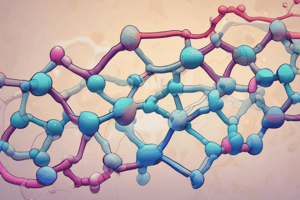Podcast
Questions and Answers
What are proteins made of?
What are proteins made of?
- Fatty acids
- Monosaccharides
- Nucleotides
- Amino acids (correct)
All amino acids are chiral except glycine.
All amino acids are chiral except glycine.
True (A)
What are some properties of amino acids that contribute to their biological functions?
What are some properties of amino acids that contribute to their biological functions?
Capacity to polymerize, useful acid-base properties, varied physical properties, varied chemical properties.
What determines the classification of amino acids?
What determines the classification of amino acids?
What is the value of pKa for the alpha carboxyl group of glycine?
What is the value of pKa for the alpha carboxyl group of glycine?
What is the isoelectric point of amino acids without ionizable side chains calculated as?
What is the isoelectric point of amino acids without ionizable side chains calculated as?
What do amino acids polymerize to form?
What do amino acids polymerize to form?
What is the pKa value for the alpha amino group of glycine?
What is the pKa value for the alpha amino group of glycine?
What are the peptide ends?
What are the peptide ends?
Amino acids can act as __________.
Amino acids can act as __________.
Name one function of peptides.
Name one function of peptides.
Flashcards are hidden until you start studying
Study Notes
Proteins
- Composed of linear chains of amino acids.
- Classified as heteropolymers consisting of alpha amino acids.
Amino Acids (General)
- All amino acids are chiral except for glycine.
- Proteins exclusively use L amino acids.
- Four essential properties support various biological functions:
- Capacity to polymerize
- Useful acid-base properties
- Varied physical properties
- Varied chemical properties
Structure of Amino Acids
- Common backbone structure with variations primarily in the R group.
- Four substituents within each amino acid:
- Carboxyl group (COO-)
- Amino group (NH3+)
- R group (side chain)
- Hydrogen atom (H)
Classification of Amino Acids
- Grouped based on R substituents:
- Nonpolar, aliphatic (7 types)
- Aromatic (3 types)
- Polar, uncharged (5 types)
- Positively charged (3 types)
- Negatively charged (2 types)
Ionization of Amino Acids
- Carboxylic acid displays an acidic pKa, becoming protonated in low pH conditions.
- Amino group shows basic pKa, remaining protonated until high pH is reached.
pH Effects on Amino Acids
- At low pH, amino acids exist primarily as cations (positively charged).
- At high pH, they predominantly take the form of anions (negatively charged).
Zwitterion Form
- Amino acids exist as zwitterions between pKa values of amino and carboxyl groups, featuring both positive and negative charges.
Isoelectric Point (pI)
- For amino acids without ionizable side chains, pI calculates as:
- pI = (pK1 + pK2) / 2
- At pI, the amino acid has a net charge of 0, is least soluble in water, and does not move in an electric field.
Buffering Capacity
- Amino acids can function as buffers due to their ability to accept or donate protons.
Uncharged Side Chains
- Example: Glycine with two pKa values:
- Alpha carboxyl group: pKa 2.34
- Alpha amino group: pKa 9.60
Ionizable Side Chains
- Ionizable side chains influence pI and can also act as buffers.
- These side chains can be titrated.
Calculation of pI with Ionizable Side Chains
- Steps to calculate pI:
- Identify species with a net zero charge.
- Find pKa value defining acid strength of the zwitterion.
- Find pKa value defining base strength of the zwitterion.
- Average these two pKa values.
Peptide Formation
- Amino acids polymerize to create peptides, which are short chains of amino acids linked by peptide bonds.
Peptide Nomenclature
- Peptides are named starting from the N-terminal using three-letter abbreviations (e.g., Ser-Gly-Tyr-Ala-Leu).
Functions of Peptides
- Peptides serve various roles such as:
- Hormones (e.g., insulin, oxytocin)
- Neuropeptides (e.g., substance P)
- Antibiotics (e.g., polymyxin B, bacitracin)
- Protective toxins (e.g., amanitin, conotoxin)
Composition of Proteins
- Proteins consist of polypeptides formed from covalently linked alpha amino acids and may include:
- Cofactors (metal ions, organic molecules)
- Coenzymes (e.g., NAD+ in lactate dehydrogenase)
- Prosthetic groups (e.g., heme in myoglobin)
- Other modifications (e.g., phosphorylation, glycosylation)
Studying That Suits You
Use AI to generate personalized quizzes and flashcards to suit your learning preferences.



